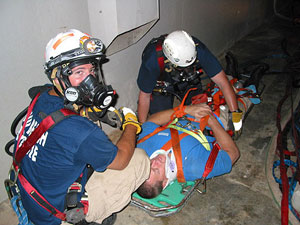Confined Space Rescue
 Confined space rescue criteria and guidelines are covered in OSHA CFR 29 1910.136 App F. Rescue teams or services have defined evaluation criteria to provide guidance to employers for choosing services for confined space permit areas. The criteria can be used to evaluate prospective or current rescue teams.
Confined space rescue criteria and guidelines are covered in OSHA CFR 29 1910.136 App F. Rescue teams or services have defined evaluation criteria to provide guidance to employers for choosing services for confined space permit areas. The criteria can be used to evaluate prospective or current rescue teams.
Before choosing or training a confined space rescue team, a satisfactory permit program must be completed, including an analysis of all permit-required confined spaces to identify all potential hazards in those spaces. Compliance with all the provisions of standard CFR 29 1910.146 should enable employers to conduct permit space operations without need for rescue services in almost all cases. However, it is still necessary to be prepared for emergency situations by selecting a on-site or off-site rescue service or team equipped and capable of minimizing harm to entrants in those situations.
Evaluation of Confined Space Rescue Teams
Evaluation in choosing a confined space rescue team has two components. An initial evaluation to decide whether a potential rescue service or team is adequately trained and equipped and whether the team can respond in a timely manner is the first step. Subsequently, a performance evaluation is needed to measure the performance of a team or service during a practice or actual rescue. In the initial evaluation, the employer can determine whether it is more cost effective to maintain an on-site confined space rescue team or to hire a rescue service. In the performance evaluation, the effectiveness of the chosen team or service can be determined and a decision made on whether to retain the current team or service based on the results or to select another service, or form an internal rescue team.
Non-Mandatory Appendix F – Rescue Team or Rescue Service Evaluation Criteria of Standard 1910.146 gives details on how to choose and evaluate a confined space rescue team or service. In addition to a description of the components of the evaluation process, it provides questions which guide the employer through the process. For the initial evaluation, answers must be determined to such questions as what is needed regarding response time; how quickly can the team or service get to the permit spaces from which rescue may be necessary; when is the rescue service available; is there an adequate method for communications between the employer and the prospective rescuer; does the rescue service have necessary skills in medical evaluation; and does the confined space rescue service have necessary equipment to perform rescues.
Confined Space Rescue Evaluation
For the performance evaluation, details must be determined such as whether all members of the service been trained as permit space entrants; are team members provided with and trained in the use of personal protective equipment (PPE); are team members trained in first aid and medical skills needed to treat victims of the type of hazards that may be encountered in the permit spaces of the facility; do team members perform their duties safely and efficiently; can the confined space rescue service properly test the atmosphere of a space and identify pertinent information from permits; and can the rescue service properly package and retrieve victims from areas with limited sized openings, limited internal space, or obstacles and other hazards. It is also important to determine if the rescue service has a plan for each type of permit space at a facility and if the plan is adequate for all types of rescue operations that may be needed at the facility.
To view the entire Non-Mandatory Appendix F – Rescue Team or Rescue Service Evaluation Criteria visit: http://www.osha.gov/pls/oshaweb/owadisp.show_document?p_table=STANDARDS&p_id=9803.